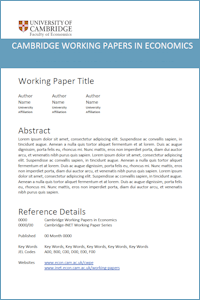
Chyong, C.-K. and Hobbs, B. F.
Strategic Eurasian Natural Gas Model for Energy Security (Revised 6 April 2011)
CWPE1134
Abstract: The mathematical formulation of a large-scale equilibrium natural gas simulation model is presented. Although large-scale natural gas models have been developed and used for energy security and policy analysis quite extensively (e.g., Holz (2007), Egging et al. (2008), Holz et al. (2009) and Lise et al. (2008)), this model differs from earlier ones in its detailed representation of the structure and operations of the Former Soviet Union (FSU) gas sector. In particular, the model represents: (i) market power of transit countries, (ii) transmission pipelines in Russia, Ukraine, Belarus and Central Asia, (iii) differentiation among gas production regions in Russia, and (iv) gas trade relations between FSU countries (e.g., Gazprom’s re-exporting of Central Asian gas). To demonstrate the model, a social benefit-cost analysis of the Nord Stream gas pipeline project from Russia to Germany via the Baltic Sea is provided. It is found that Nord Stream project is profitable for its investors and the project also improves social welfare in all market power scenarios. Also, if transit countries (Ukraine and Belarus) exert substantial market power then the economic value of Nord Stream to its investors and to society improves substantially. We also found that the value of Nord Stream investment is rather sensitive to the degree of downstream competition in European markets and that lack of downstream competition might result in the negative value of the Nord Stream system to Gazprom.
Keywords: Complementarity modelling, optimization, Nord Stream, South Stream, Russia, transit, pipeline, Gazprom, energy security, Europe
JEL Codes: C61 C72 L13 L95 H43
PDF: https://www.econ.cam.ac.uk/research-files/repec/cam/pdf/cwpe1134.pdf 
EPRG Paper Link: 1115
Open Access Link: https://doi.org/10.17863/CAM.1174
